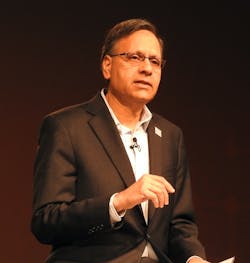Chand shared with the more than 2,100 attendees of this week’s Rockwell Automation TechED event in Orlando how the company’s control and information architecture is designed to liberate longstanding silos of information, as well as incorporate and build upon new, disruptive technologies as they arise – all in the pursuit of improvements in time-to-market, asset utilization, total cost of ownership and enterprise risk management for its industrial customers.
“The convergence of IT and OT is happening now,” Chand said, noting the rising tally of connected devices (to 50 billion by 2020), the proliferation of collaborative robots (or ‘cobots’) in industrial environments, the increased application of artificial intelligence and machine learning to predict pending operational failures, and the effects of wearables and mobile technology on information accessibility and workflows. “These technology trends are only accelerating The Connected Enterprise,” Chand said.
Liberated information silos
In particular, the opening and integration of formerly siloed sources of information is enabling dramatic gains in productivity, Chand said, citing the 4-5% annual productivity gains that Rockwell Automation has realized since itself becoming a Connected Enterprise. “Take the information that exists in your data silos and bring it into operations and other phases of the asset lifecycle,” Chand said.
“Will every bit of data be sent to the cloud? Not likely.” Rockwell Automation CTO Sujeet Chand on the company’s two-tiered approach to real-time analytics performed locally and higher level analytics for optimization tasks.
An example of this might include a wiring design diagram generated in Eplan that, once built, was seldom accessed again. In The Connected Enterprise, Chand said, that diagram is available to help troubleshoot operations and maintenance activities. Benefits realized due to this improved information access include more tightly integrated design and simulation activities, improved project delivery time, more sustainable production and better overall equipment effectiveness (OEE), together with optimization of asset uptime, production throughput and energy use.From an architectural perspective, smart assets are at the center of The Connected Enterprise vision, surrounded by groups of enabling technologies such as mobility and visibility, information management and analytics, scalable computing (edge, control and cloud), multi-disciplinary control and secure network infrastructure. These core platform enablers are, in turn, surrounded by technologies a step further removed, such as the Internet of Things (IoT), augmented and virtual reality (AR/VR), multivariable optimization, and end-to-end security. With these elements in place, “we now have the right architecture for implementing The Connected Enterprise.”
Analytics where needed
The Connected Enterprise also is designed to accommodate analytics wherever they are most appropriately deployed. “We estimate that 80% of analytics will continue to be done on premise, enabled by continued advances in local computing power,” Chand said. “Real-time analytics, meaning those that result in a controller setpoint change or alarm displayed to an operator, must be done on premise,” Chand said.
“Meanwhile, the cloud has a distinct role to play, particularly in the area of historicized data and for remote assets,” Chand said. “But will every bit of data be sent to the cloud? Not likely.”
An example of this tiered approach to analytics is a recent solution deployed by Rockwell Automation to maintain and optimize operation of production assets in oil & gas fields. Instead of relying on periodic maintenance rounds to detect malfunctioning wells, down-hole sensors together with ControlLogix-based real-time analytics detect and alert operations to actual and pending problems. Meanwhile, a distilled view of individual well data is transferred to the cloud, where analytics can optimize oilfield performance across multiple individual wells.
“The Rockwell Automation cloud platform is based on Microsoft Azure,” Chand explained. “This allows you to leverage whichever of the many analytics solutions available are most appropriate. Look at the business outcomes you are trying to achieve, then plug in whichever analytics you need.”
While The Connected Enterprise can do much to improve industrial performance today, it will become even more capable in the future, concluded Chand. “We’re working to make it increasingly predictive and optimized. Longer term, it will be both self-adaptive and self-healing.”








